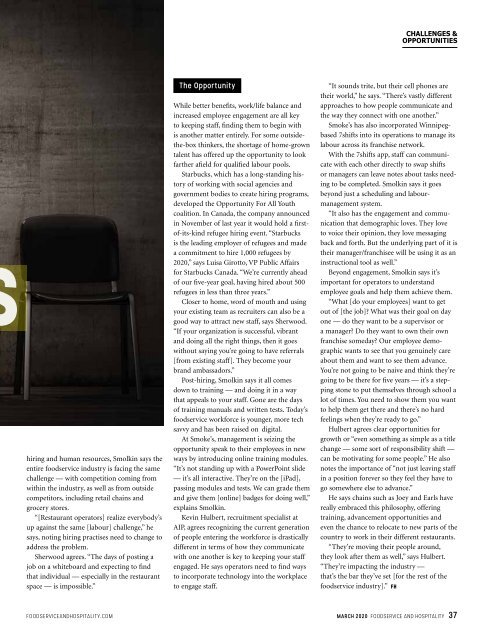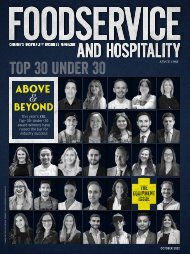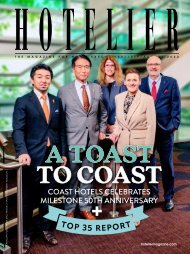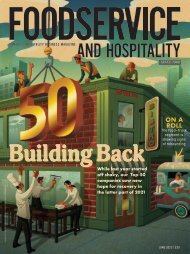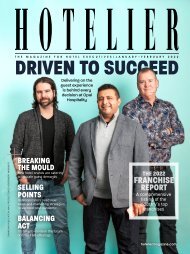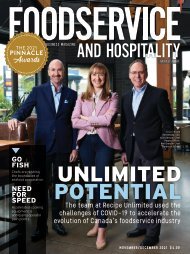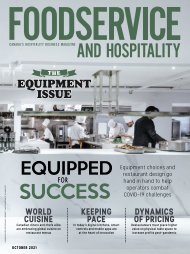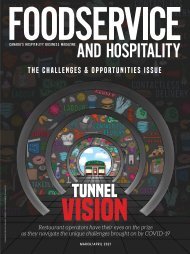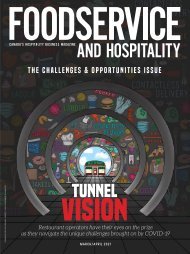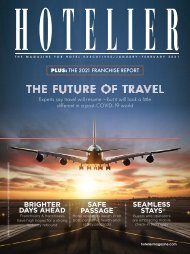FH0320
Create successful ePaper yourself
Turn your PDF publications into a flip-book with our unique Google optimized e-Paper software.
CHALLENGES &<br />
OPPORTUNITIES<br />
hiring and human resources, Smolkin says the<br />
entire foodservice industry is facing the same<br />
challenge — with competition coming from<br />
within the industry, as well as from outside<br />
competitors, including retail chains and<br />
grocery stores.<br />
“[Restaurant operators] realize everybody’s<br />
up against the same [labour] challenge,” he<br />
says, noting hiring practises need to change to<br />
address the problem.<br />
Sherwood agrees. “The days of posting a<br />
job on a whiteboard and expecting to find<br />
that individual — especially in the restaurant<br />
space — is impossible.”<br />
The Opportunity |<br />
While better benefits, work/life balance and<br />
increased employee engagement are all key<br />
to keeping staff, finding them to begin with<br />
is another matter entirely. For some outsidethe-box<br />
thinkers, the shortage of home-grown<br />
talent has offered up the opportunity to look<br />
farther afield for qualified labour pools.<br />
Starbucks, which has a long-standing history<br />
of working with social agencies and<br />
government bodies to create hiring programs,<br />
developed the Opportunity For All Youth<br />
coalition. In Canada, the company announced<br />
in November of last year it would hold a firstof-its-kind<br />
refugee hiring event. “Starbucks<br />
is the leading employer of refugees and made<br />
a commitment to hire 1,000 refugees by<br />
2020,” says Luisa Girotto, VP Public Affairs<br />
for Starbucks Canada. “We’re currently ahead<br />
of our five-year goal, having hired about 500<br />
refugees in less than three years.”<br />
Closer to home, word of mouth and using<br />
your existing team as recruiters can also be a<br />
good way to attract new staff, says Sherwood.<br />
“If your organization is successful, vibrant<br />
and doing all the right things, then it goes<br />
without saying you’re going to have referrals<br />
[from existing staff]. They become your<br />
brand ambassadors.”<br />
Post-hiring, Smolkin says it all comes<br />
down to training — and doing it in a way<br />
that appeals to your staff. Gone are the days<br />
of training manuals and written tests. Today’s<br />
foodservice workforce is younger, more tech<br />
savvy and has been raised on digital.<br />
At Smoke’s, management is seizing the<br />
opportunity speak to their employees in new<br />
ways by introducing online training modules.<br />
“It’s not standing up with a PowerPoint slide<br />
— it’s all interactive. They’re on the [iPad],<br />
passing modules and tests. We can grade them<br />
and give them [online] badges for doing well,”<br />
explains Smolkin.<br />
Kevin Hulbert, recruitment specialist at<br />
AIP, agrees recognizing the current generation<br />
of people entering the workforce is drastically<br />
different in terms of how they communicate<br />
with one another is key to keeping your staff<br />
engaged. He says operators need to find ways<br />
to incorporate technology into the workplace<br />
to engage staff.<br />
“It sounds trite, but their cell phones are<br />
their world,” he says. “There’s vastly different<br />
approaches to how people communicate and<br />
the way they connect with one another.”<br />
Smoke’s has also incorporated Winnipegbased<br />
7shifts into its operations to manage its<br />
labour across its franchise network.<br />
With the 7shifts app, staff can communicate<br />
with each other directly to swap shifts<br />
or managers can leave notes about tasks needing<br />
to be completed. Smolkin says it goes<br />
beyond just a scheduling and labourmanagement<br />
system.<br />
“It also has the engagement and communication<br />
that demographic loves. They love<br />
to voice their opinion, they love messaging<br />
back and forth. But the underlying part of it is<br />
their manager/franchisee will be using it as an<br />
instructional tool as well.”<br />
Beyond engagement, Smolkin says it’s<br />
important for operators to understand<br />
employee goals and help them achieve them.<br />
“What [do your employees] want to get<br />
out of [the job]? What was their goal on day<br />
one — do they want to be a supervisor or<br />
a manager? Do they want to own their own<br />
franchise someday? Our employee demographic<br />
wants to see that you genuinely care<br />
about them and want to see them advance.<br />
You’re not going to be naive and think they’re<br />
going to be there for five years — it’s a stepping<br />
stone to put themselves through school a<br />
lot of times. You need to show them you want<br />
to help them get there and there’s no hard<br />
feelings when they’re ready to go.”<br />
Hulbert agrees clear opportunities for<br />
growth or “even something as simple as a title<br />
change — some sort of responsibility shift —<br />
can be motivating for some people.” He also<br />
notes the importance of “not just leaving staff<br />
in a position forever so they feel they have to<br />
go somewhere else to advance.”<br />
He says chains such as Joey and Earls have<br />
really embraced this philosophy, offering<br />
training, advancement opportunities and<br />
even the chance to relocate to new parts of the<br />
country to work in their different restaurants.<br />
“They’re moving their people around,<br />
they look after them as well,” says Hulbert.<br />
“They’re impacting the industry —<br />
that’s the bar they’ve set [for the rest of the<br />
foodservice industry].” FH<br />
FOODSERVICEANDHOSPITALITY.COM<br />
MARCH 2020 FOODSERVICE AND HOSPITALITY 37


